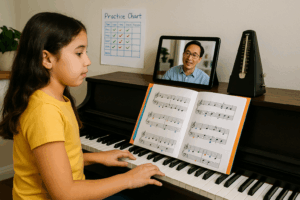When we recommend metronomes to new students, we often hear hesitation. “Isn’t that just for professionals?” “Won’t it make practice boring?” “My child already has a good sense of rhythm.”
We get it—metronomes have a reputation. But as private music teachers who work with beginner students every day, we can say with confidence: using a metronome at home builds better timing, stronger confidence, and faster progress. This guide busts common myths and shows you why using a metronome at home is one of the smartest practice tools around.
Myth #1: Metronomes Are Only for Advanced Musicians
Truth: Beginners benefit even more from a steady beat. Learning to stay in time early on creates solid habits that last a lifetime.
We introduce metronomes within the first few weeks of lessons—often starting with clapping or simple exercises to build comfort and confidence.
Myth #2: Metronomes Make Practice Boring
Truth: Used creatively, metronomes actually increase engagement. Here’s how we make it fun:
-
Turn it into a game: Can you stay on beat for 8 measures straight?
-
Change the speed: Start slow, then gradually increase tempo
-
Use a metronome app with different sounds or visual cues
Some of our students love using Soundbrenner, a free app that lets them feel the beat with vibration or tap it out interactively.
Myth #3: My Child Already Has Good Rhythm
Truth: Rhythm is more than just “feeling the beat.” It’s about aligning with others, learning consistency, and improving over time. Even naturally rhythmic students need tools to stay locked in during practice and performance.
We often use the metronome to help students correct rushing, dragging, or inconsistent tempos in pieces they think they know well.
How to Introduce the Metronome at Home
Try this:
-
Clap along with the metronome at a slow tempo
-
Play a one-hand exercise (like a scale or short phrase) in time
-
Increase tempo gradually—but only if accuracy stays solid
-
Make it a habit—use the metronome for 5 minutes at the start of each practice
Want more beginner-friendly practice tips? Read our blog on how to make music practice fun and productive to build consistency in enjoyable ways.
FAQ: Metronomes in Music Lessons
When should a student start using a metronome?
Most students begin within their first month of lessons, especially when working on basic rhythm exercises or scales.
Are physical metronomes better than apps?
Both work well. Some students prefer apps for convenience and variety, while others focus better with a classic click or visual pendulum.
Can metronomes be used with all instruments?
Yes! Whether your child plays piano, violin, guitar, or flute, a metronome helps build steady timing across all styles and levels.
